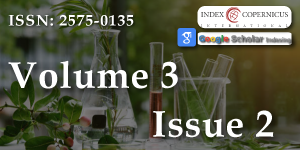Effect of Khaya Senegalensis Bark and Oil on Post-Harvest Fungal Agents of Groundnut Seeds Rot in Adamawa State, Nigeria
Main Article Content
Abstract
Standardized method of seed treatment is of prime importance in the production of groundnut. The study was to carry out control trial using bark extract (aqueous and ethanol) and oil (seed) of mahogany (Khaya senegalensis) on seven (7) isolated fungi from two groundnut varieties (peruvian and valencia). The result shows that both mahogany bark and seed extracts are capable of inhibiting mycelial growth of all the isolates. There was no significant variation between the aqueous and ethanol bark extracts in-vitro, however the in-vivo test shows a significant difference between the aqueous and the ethanol bark extract in which the ethanol extract reduced growth of the pathogens more than the aqueous. For all the pathogens except Rhizopus stolonifer there was no growth between 50% to 100% concentration of the Khaya senegalensis oil in-vitro, however in-vivo control at 50% produced scanty to moderate growth for all the pathogens except Rhizopus stolonifer on peruvian, while there was full coverage on the seeds of valencia variety with Aspergillus niger and Rhizopus stolonifer having total coverage though Pseudaiiescheria boydii and Cylindrocarpon lichenicola were effectively inhibited and showed no growth at the 50% and 100%. Further research to focus on the quantifying the chemical constituents and formulation are suggested.
Article Details
Copyright (c) 2019 Channya FK, et al.

This work is licensed under a Creative Commons Attribution 4.0 International License.
Weiss EA. Oilseed Crops. 2nd edition. Blackwell Science Ltd., Oxford, London, BerlinCarlton, Paris. 2000; 31-36.
Al-Amod MO. Seed-borne fungi of some peanut varieties from Hadhramout and Abyan Governorates in Yemen. International Journal of Agricultural Technology. 2015; 11: 1359-1370.
Osman RA. Occurrence and Identitication of Seed Borne Fungi Associated with Groundnuts in Kordofan States. A Thesis Submitted in Partial Fulfillment of the Requirements for the M.Sc. Degree in Plant Protection. Sudan University of Science and Technology College of Graduate Studies and Scientific Research University of Zalingei. 2016.
Elwakil MA, El-Metwally MA. Seed-borne Fungi of Peanut in Egypt; Pathogenicity and Transmission. Pakistan of Biological Science. 2001; 4: 63-68.
Chavan AM, Kakde RB. Studies on abnormal oilseeds mycoflora from Marathwada region. Bionano Frontier. 2008; 2: 101-104.
Olusegun A, Hussaini AM, Isaac MO, Mojisola E, Kingsley OI, et al. Fungal and Mycotoxin Contamination of Nigerian Foods and Feeds: in Mycotoxin and Food Safety in Developing Countries, edited by Hussaini Anthony Makun, ISBN 978-953-51-1096-5. 2013.
Manimurugan C. Pathogen Free Seed Production in Black Gram (Vigna mungo (L.) Hepper). M.sc. (Ag.) Thesis, Tamil Nadu Agricultural University, Coimbatore, Tamil Nadu. 2003.
Ahmad I, Beg A. Antimicrobial phytochemical studies on 45 Indian medicinal plants against multi-drug resistant human pathogens. Journal Ethno. Pharmacy. 2007; 7: 113-123. PubMed: https://www.ncbi.nlm.nih.gov/pubmed/11167029
Ajobade TA and Amusa A. Evaluation of antifungal efficacy of some plant extract on cusvularia. Lunate the causal organisms of leaf spot. African Journal of Environment sciences and technology. 2001; 4: 1010
Jennings AA, Li Z. Residential surface soil guidance applied worldwide to the pesticides added to the Stockholm Convention in 2009 and 2011. J. Environmental Manag. 2015; 160: 226-240. PubMed: https://www.ncbi.nlm.nih.gov/pubmed/26144561
Fantke P, Juraske R, Antón A, Friedrich R, Jolliet O. Dynamic multicrop model to characterize impacts of pesticides in food. Environ. Sci. Technol. 2011; 45: 8842-8849.PubMed: https://www.ncbi.nlm.nih.gov/pubmed/21905656
Fantke P, Friedrich R, Jolliet O. Health impact and damage cost assessment of pesticides in Europe. Environ. Int. 2012; 49: 9-17.PubMed: https://www.ncbi.nlm.nih.gov/pubmed/22940502
Odukkathil G, Vasudevan, N. Residues of endosulfan in surface and subsurface agricultural soil and its bioremediation. J. Environ. Manag. 2016; 165: 72-80. PubMed: https://www.ncbi.nlm.nih.gov/pubmed/26413801
Orton TG, Saby NPA, Arrouays D, Jolivet CC, Villanneau EJ, et al. Spatial distribution of lindane concentration in topsoil across France. Sci. Total Environ. 2013; 443: 338-350. PubMed: https://www.ncbi.nlm.nih.gov/pubmed/23202380
Li Z, Jennings A. Global variations in pesticide regulations and health risk assessment of maximum concentration levels in drinking water. J Environ Manag. 2018; 212: 384-394.PubMed: https://www.ncbi.nlm.nih.gov/pubmed/29455146
Ademola IO, Fagbemi BO, Idowu SO. Evaluation of antihelminthic activity of Khaya senegalensis extracts against gastro intestinal nematodes of sheep: in vitro and in vivo studies. Vet. Parasitol. 2004; 122: 151-164. PubMed: https://www.ncbi.nlm.nih.gov/pubmed/15177720
Abdelgaleil SAM, Iwagawa T, Doe M, Nakatani M. Antifungal limonoids from the fruits of Khaya senegalensis. Fitoterapia. 2004; 75: 566-572. PubMed: https://www.ncbi.nlm.nih.gov/pubmed/15351110
Abdelgaleil SAM, Okamura H, Iwagawa T, Sato A, Miyihara I, et al. Khayanolides rearranged phragmalin limonoid antifeedants from Khaya senegalensis. Tetrahedron. 2001; 57: 119-126.
Ijato JY, Otoide JE, Ijadunola JA, Aladejimokun AO. Efficacy of antimicrobial effect of Venonia amygdalina and Tridax procumbens in in vitro control of tomato (Lycopersicum esculentum) post -harvest fruit rot. Report and Opinion. 2011; 3: 120-123.
Gomez KA, Gomez AA. Statistical Procedure for Agriculi tural Research. 2nd ed. Wiley. 1984; 680.
Scheff HA. Method of judging all contrast in the Analysis of Variance. Biometric. 1953; 40: 104-107.
Abdulsalam AA, Zakari BG, Chimbekujwo IB, Channya FK, Bristone B. Isolation and Control of Fungi Associated with Neck Rot Disease of Onions (Allium cepa L.) In Bama, Borno State, Nigeria. Global Journal of Biology, Agriculture and Health Sciences. 2015;4: 35-39.
Liman IB, Ibrahim S, Rabah NT. The efficacy of Mahogany leaf extract on Root knot nematode disease of tomato (Lycopersicon esculentum. Nigerian Journal of Basic and Applied Sciences. 2010; 18: 272-276.
Montes BR. Natural Plant Products to Combact Pathogens. Mexican Journal of Phytopathology. 1996; 14: 9-14.
Khare NP, Lucas B, Seavey KC, Liu YA, Sirohi A, et al. Steady State and Dynamic Modeling of Gas-Phase Polypropylene Processes using Stirred-Bed Reactors. Ind. Eng. Chem. Res. 2004; 43: 884.
O’Bryne DJ, Knauft DA, Shireman RB. Low fat monounsaturated rich diets containing high-oleate peanuts improve serum lipoprotein profiles. Lipids.1997; 32: 687-695.PubMed: https://www.ncbi.nlm.nih.gov/pubmed/9252956
Bamaiyi LJ, Ndams IS, Toro WA, Odekina S. Effect of mahogany (Khaya senegalensis) seed oil in control of Callosobruchus maculatus on stored cowpea. Plant Protect. Sci. 2006; 42: 130-134.

